The Mercedes SLR is one of the most iconic names in the world of automotive and racing. From the Silver Arrows to the Mille Miglia, from drivers like Juan Manual Fangio and Stirling Moss to teams like Mercedes and McLaren, the SLR embodies it all.
The roots of the Mercedes-Benz SLR McLaren could be traced back to the 1950s, an era which marked both the best and worst in auto racing for Mercedes-Benz. The German manufacturer has been involved throughout its history in motorsports.
At the pinnacle of its success the Silberpfeilen (Silver Arrows) made in Stuttgart dominated in Formula One, sports car racing and rallies. It was in those days Mercedes developed the iconic 300 SLR. Because of its lightweight construction the sports car was dubbed SLR, an abbreviation of Sport, Leight, Rennsport which could be translated as ‘Sport, Light, Racing’. The SLR was initially designated as W196S, but Mercedes’ marketing department wasn’t pleased with this “uninspiring name” and came up with the 300 SLR. Although the name suggest otherwise, the car wasn’t based on the famous 300 SL Gullwing.
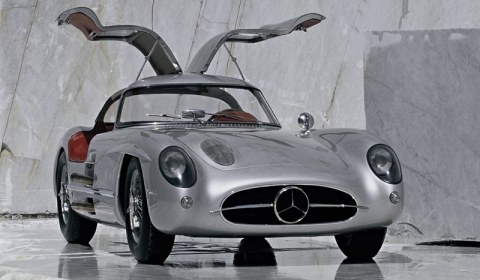
The Mercedes-Benz 300 SLR was based on the Mercedes-Benz W196, which was driven by Juan Manuel Fangio and Stirling Moss in the 1954 and 1955 Formula One seasons. The W196 was not only the fastest, but also the most technologically advanced car on the track. And it was also the most successful as it won nine of the twelve races in which it started. The Mercedes-Benz 300 SLR was developed for and used in the 1955 World Sportscar Championship season. In this series of important endurance and road racing events the Benz was also very successful as Mercedes won the championship with the 300 SLR.
The most important victory was without a doubt the Mille Miglia, an almost 1,600km long road race through Italy. Stirling Moss and his navigator Denis Jenkinson entered the race in their Mercedes bearing the now famous number 722. This number was assigned according to their start time (7:22 AM). The British driver and co-pilot won the Thousand Miles with a record breaking average speed of 157.65km/h. Moss stated the 300 SLR was “the greatest sports car ever made ‒ really an unbelievable machine”.
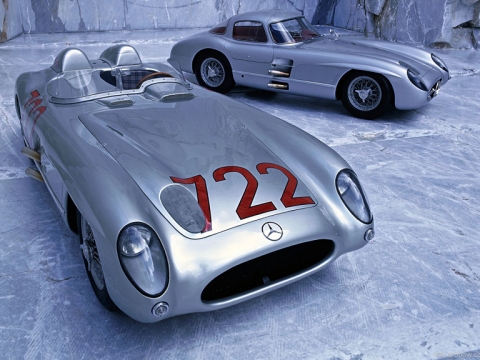
Sadly the winning streak of Mercedes ended with the horrible crash at Le Mans. During the 1955 edition of the endurance race, Pierre Levegh’s 300 SLR crashed into a crowd, killing the driver and more than 80 spectators. Following this tragedy, Mercedes-Benz withdrew from all factory-sponsored motorsport. Almost four decades followed before the Mercedes returned to the highest level of auto racing.
The man who created the W196 and 300 SLR was motorsport chief Rudolf Uhlenhaut. He wanted to create a street-legal version of the 300 SLR by combining the road going 300 SL Gullwing with the powerful race car. Uhlenhaut’s idea was a create a sports car which could be used for testing and preparations for the next season. Two road-legal SLRs were built, they became known as the 300 SLR Uhlenhaut Coupé and were regarded as the world’s fastest cars in those days. Because of the tragedy at Le Mans followed by Mercedes’ withdrawal, the cars became obsolete. So Uhlenhaut used one as his own company car. And according to rumours, it was indeed quite fast. The story goes that Rudolf Uhlenhaut was late for a meeting, so he used the unlimited Autobahn to travel the 220km between Stuttgart in Munich in just over an hour.
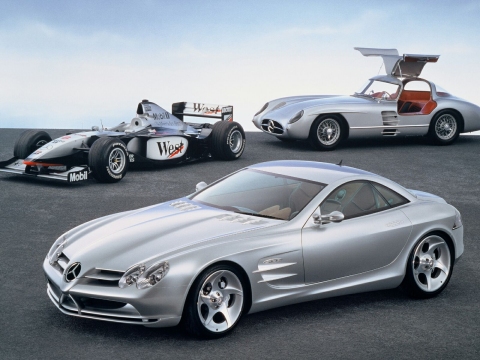
Many years passed before Mercedes returned to Formula One, this time not as constructor but as an engine supplier to Sauber in 1993. But in 1995 Mercedes moved to McLaren, the British team which dominated the eighties with Nika Lauda, and especially Ayrton Senna and Alain Prost. During this era McLaren was responsible for seven drivers’ championships and six constructors’ championships. But when Mercedes joined McLaren, the team was struggling. The last race was won in 1993. But eventually the partnership resulted in victories, and Mika Häkkinen became with McLaren-Mercedes world champion in 1998 and 1999. Inspired by this success ‒ and considering the fact Mercedes’ parent company DaimlerChrysler held a majority of the McLaren Group’s shares ‒ the relationship between McLaren and Mercedes was extended onto the street.
The result of the collaboration between the two giants of auto racing was the conceptual Mercedes-Benz Vision SLR, which was unveiled in 1999. The name and styling honoured its predecessors from the fifties. The two-seater was based on the SL-Class (R129) and embodied the best of Mercedes and McLaren. It was designed to combine luxury, comfort, reliability and of course Mercedes’ racing legacy with the sportive character, performance and engineering of McLaren. Four years later Mercedes presented an upgraded and almost production ready model named the Vision SLR Roadster.
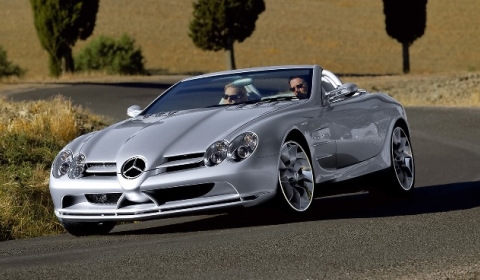
Finally production of the Mercedes SLR McLaren started in 2003 at the McLaren Technology Centre in Woking, England. More than 500 units were delivered to customers during the first full year of production.
The SLR McLaren is powered by 5.4 liter V8 equipped with a supercharger producing 0.9 bar of boost. The hand-built AMG engine is positioned behind the front axle and delivers 626 horsepower at 6,500rpm. The maximum torque of 780Nm is available from 3,250rpm and remains at this level up to 5,000rpm. The front-mid engine is paired with a five-speed automatic transmission which transfers the power to the rear wheels.
Thanks to all of this, the SLR McLaren is able to accelerate from standstill to 100km/h in 3.8 seconds, although is has been reported in some tests that the car could accelerate even faster. The SLR reaches the 200 mark after 10.6 seconds and the 300 is hit in 28.8 seconds. The quarter mile is done within 11.2 seconds and the top speed is at 334km/h.
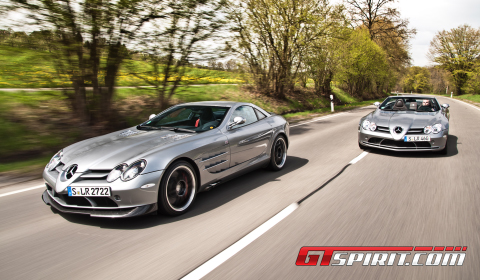
For stopping power the SLR McLaren is fitted with carbon ceramic brakes combined with an another remarkable feature, the adaptable spoiler which serves as airbrake. Once pioneered by Mercedes’ director of motorsports Alfred Neubauer, who introduced this concept at Le Mans in 1955, the SLR McLaren uses an airbrake to help the carbon ceramic brakes. If the driver steps heavily on the brakes, the rear spoiler rises to an angle of 65 degrees, thus creating more aerodynamic drag and stability and therefore boosting the deceleration. When driving 100km/h, it takes no more than 34.9 meters to come to a complete standstill. Another reference to the famous 300 SLR Uhlenhaut Coupé are the exhaust pipes placed on the side of the car.
The body is made from carbon fiber in order to add more rigidity, strength, safety, and to save weight. Despite the use of this lightweight material the total curb weight of the SLR is 1,750kg, making it heavier than competitors like the Aston Martin DBS V12, Ferrari 599 GTB, Lamborghini Murciélago, Porsche Carrera GT. Nevertheless the Benz’ performance is on par with its rivals.
In 2006 the SLR was succeeded by the more powerful and slightly more aggressive styled Mercedes-Benz SLR Mclaren 722 Edition. The number ‘722’ refers to the starting number of Stirling Moss’ Mille Miglia winning Mercedes Benz 300 SLR. The engine of the 722 Edition was upgraded and delivered now 650hp. The performance increased as well, the 722 Edition sprints from standstill to 100km/h in only 3.6 seconds, and 200km/h is reached in just 10.2 seconds. The maximum speed of 337km/h is above the 334km/h of the standard SLR. Furthermore the brakes increased in size, and the exterior received a small upgrade as well. In addition to the coupe version a roadster version of the SLR entered the market in 2007. The convertible featured the same power plant and specs as its closed sibling. (Mercedes-Benz SLR McLaren 722 Coupe and SLR McLaren Roadster visible in gallery below)
One year later the exclusively for the racetrack-designed SLR 722 GT was unveiled, whereby the suspension, braking system, aerodynamics, interior and exhaust system were modified for the track by British engineering company RML Group. The engineers shed almost 400kg of weight, resulting in a dry weight to 1,300kg. Due to the supercharger’s 1.75 bar boost, the maximum output increased to 680hp and 830Nm of torque. This enabled the SLR 722 GT to accelerate from standstill to 100km/h in 3.3 seconds. The production of the most powerful SLR was limited to only 21 units.
With the Roadster 722 S an other limited edition of the SLR entered the market. A total of 150 examples of the more powerful roadster were made. With an output of 650hp and 820Nm of torque, the open two-seater is able to reach 100km/h from standstill in 3.6 seconds and a top speed of 334km/h. Production of the roadster ended in May 2009, paving the way for the crown jewel of the SLR range: the Stirling Moss.
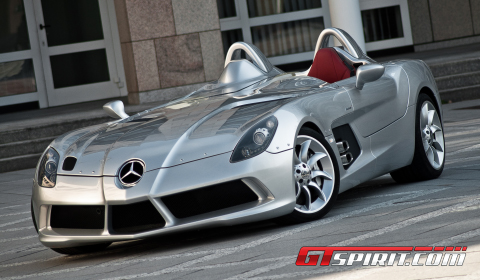
The Mercedes SLR McLaren Stirling Moss is the ultimate tribute to Stirling Moss. Limited at 75 units, the speedster was built according to the same spirit as the classic 300 SLR which won the 1955 Mille Miglia. There is neither a roof nor a windscreen to separate the driver and passenger from the outside world, just like SLR driven by Moss and Jenkinson. The supercharged V8 of the SLR McLaren Stirling Moss pumps out 650hp, giving the speedster the ability to accelerate to 100km/h in less than 3.5 seconds. With a top speed of 350km/h the window- and roofless car is faster than any of the other SLR’s. It was also supposed to be the last of the range.
Although the Stirling Moss was the swansong for the SLR, the final curtain finally fell with the McLaren Edition in 2010 ‒ a year on from the end of production. Almost out of the blue, McLaren presented their final take on the SLR at the 2010 Essen Motor Show. The SLR Edition featured a revised bodywork, modified steering and suspension set-up. Production was limited to only 25 pieces.
When the final SLR left the production line in Woking, the collaboration between Mercedes and McLaren also came to an end. It has been rumoured McLaren wasn’t entirely happy with the SLR ‒ they wanted it to be less grand tourer and more purebred sports car. But Mercedes insisted on a more practical, comfortable and reliable car, almost suitable for daily use. It has been suggested ‒ even used as to criticize the Mercedes-Benz SLR McLaren ‒ that the car was a bad compromise which was the result of two conflicting points of view.
Initially and perhaps in an optimistic mood Mercedes-Benz announced at the SLR’s introduction that they were targeting a total production of 3,500 SLR over seven years, much more than all of its competitors. This implied an annual production of 500 cars despite its quite hefty price tag. Sadly though for the bosses in Stuttgart and Woking, the SLR failed to live up these expectations.
But it should be noticed that with well over 2,000 units built, the Mercedes SLR McLaren is still one of the most successful high-end supercars from ever made. And perhaps this is especially made possible because it’s a compromise, reflecting the best of two worlds. And besides, no one could argue that the Stirling Moss is compromising ‒ in fact it’s one of the most uncompromising cars ever made ‒ and it surely a great tribute to a great driver, but also to the SLR itself.





















































































Great car, i love the SLR. Specially the 722S.
That’s a class material, congrats. Hopefully I’ll drive Stirling Moss someday as well, that’s my favourite modern day supercar :)